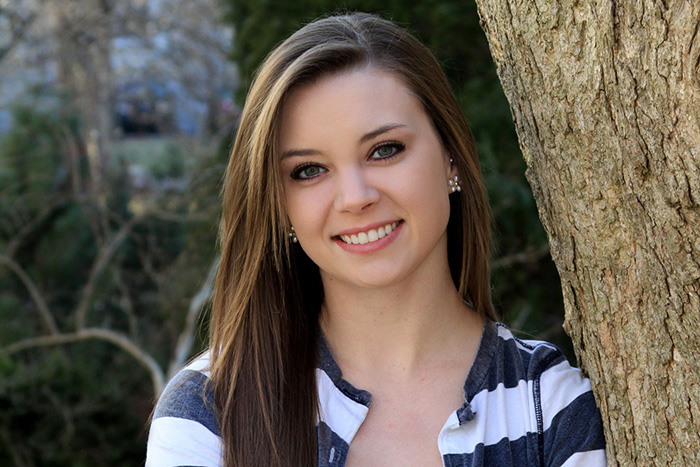Dickinson College
Striving for Educational Equity

As associate director of research at the Johns Hopkins Center for Talented Youth, former psychology major Ashley Flynn ’11 strives to make the field of gifted education more accessible and equitable for all. In this rewarding career, she combines her passions, experiences and skills to improve testing and identify alternative measures for gifted identification placement.
Can you speak to how Dickinson’s useful liberal-arts education helped you along your career path?
As a high school student, I was often asked, “Are you a math/science person or an English/history person?” I had a nontraditional answer that my parents and teachers were surprised to hear—“neither.” Math, language and scientific research were my passions, and I felt like an anomaly until I took my first psychology class as an undergraduate student, “Perception, Memory and Thought.” In my first semester at Dickinson College, I found an academic concentration that combined my passions, academic interests and strengths, and I finally had an answer: “I am a psychology person.” Dickinson allowed me to explore the intersection of my interests, which I have carried with me throughout my career as I now work as a researcher at the intersection of education, cognitive psychology and neuroscience. In addition, Dickinson’s liberal-arts approach fostered and cultivated my love of learning. Since graduating, I have earned an M.S. in education and am currently working toward a doctorate in educational neuroscience at Johns Hopkins University.
What was your favorite activity/organization at Dickinson?
I was a member of Pi Beta Phi and loved the community service projects and fundraisers we led. My favorite volunteer opportunity was reading to children at the Bosler Library—it was a great way to connect with the community around us and begin working with younger students. I also really enjoyed the rush process, both as a recruit and a sorority member—it was great to meet new people with whom you wouldn’t typically cross paths.
What jumps out as a great memory from your time at Dickinson?
I spent my junior year abroad in Bologna, and this is by far my greatest memory from my time at Dickinson. Although this was primarily a political science program, Dickinson allowed me to tailor it to my interests, and I was able to intern at a psychiatry practice, teach English at a local school, and take Italian language and literature courses in addition to political science.
How do you stay involved with/support Dickinson? Why do you think it’s important?
My favorite way to support Dickinson as an alumna is to help current students and recent alumni with their careers. I think it’s critical that we provide networking and mentorship to younger Dickinsonians to help them achieve their professional goals. If anyone is interested in cognitive neuroscience or education, I’m happy to connect!
How did you get interested in your work, and what about it excites you most?
As a sophomore, I took an education course with Associate Professor of Educational Studies Elizabeth Lewis and read The Shame of the Nation by Jonathan Kozol, which exposed me to the pervasive educational inequities in our country. This course inspired me to apply to Teach for America, and I joined the corps upon graduating, becoming a high school math and psychology teacher in Baltimore City. My passion for educational equity continued to grow through this experience, but I was missing the psychological research I fell in love with at Dickinson. I then transitioned to the Johns Hopkins Center for Talented Youth, where I could combine all my passions, experience and skills, which is what excites me most about my current work.
What does your current work entail?
As the associate director of research at the Johns Hopkins Center for Talented Youth, I combine cognitive psychology and neuroscience to understand the cognitive profiles of advanced learners. In addition, since traditional standardized tests miss a great deal of academic potential due to the cultural bias and charge inherent in these assessments, I investigate alternative identification methods to help make the field of gifted education more accessible and equitable for all.
I have the following quote from Supreme Court Justice Sonia Sotomayor framed on my desk, and it guides my work every day: “We are never going to reach equality in America until we achieve equality in education. That’s why we’re unequal in this society, and it’s what we need to change if we want all people equal—not just under law—but in participation in society.”
What is the most challenging part of your work?
As a researcher, I work with data that reflects the current state of our educational system, which can be disheartening. For example, a quick glance at national data reveals that although Black and Latinx students make up approximately 16% and 25% of our country’s public-school population, only 10% and 18% are identified as gifted, respectively (U.S. Department of Education, 2014). However, I am encouraged by some of the preliminary data we’re finding about more fundamental cognitive skills like working memory, executive functioning and spatial skills that are good candidates for alternative identification measures for gifted identification placement.
What comes to mind as something unforgettable that you’ve done since you graduated?
I will never forget becoming a high school teacher at age 22. Some of my students were only three years younger than I was, so I quickly learned the importance of classroom management and not revealing my age!
You just built a time machine: where and when do you go?
I would go back to 2009 when I was studying abroad in Italy!
TAKE THE NEXT STEPS
Published February 2, 2021